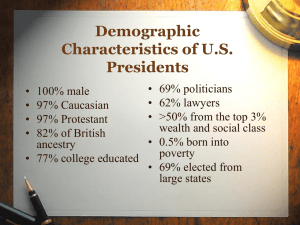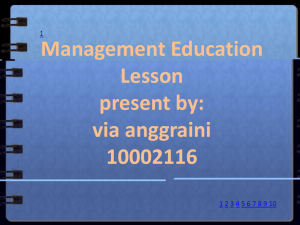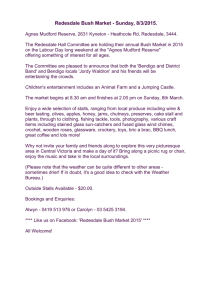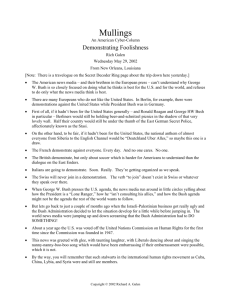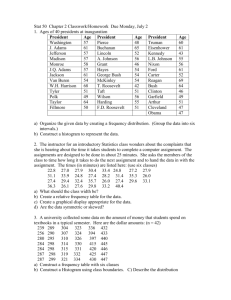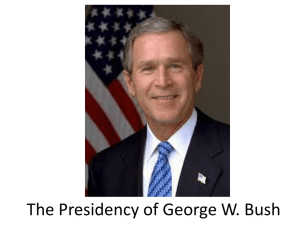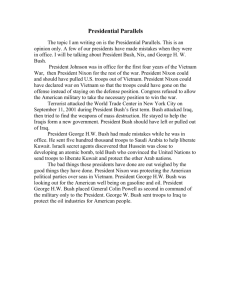Paper The rhetorical world of George W. Bush Jan Blommaert
advertisement
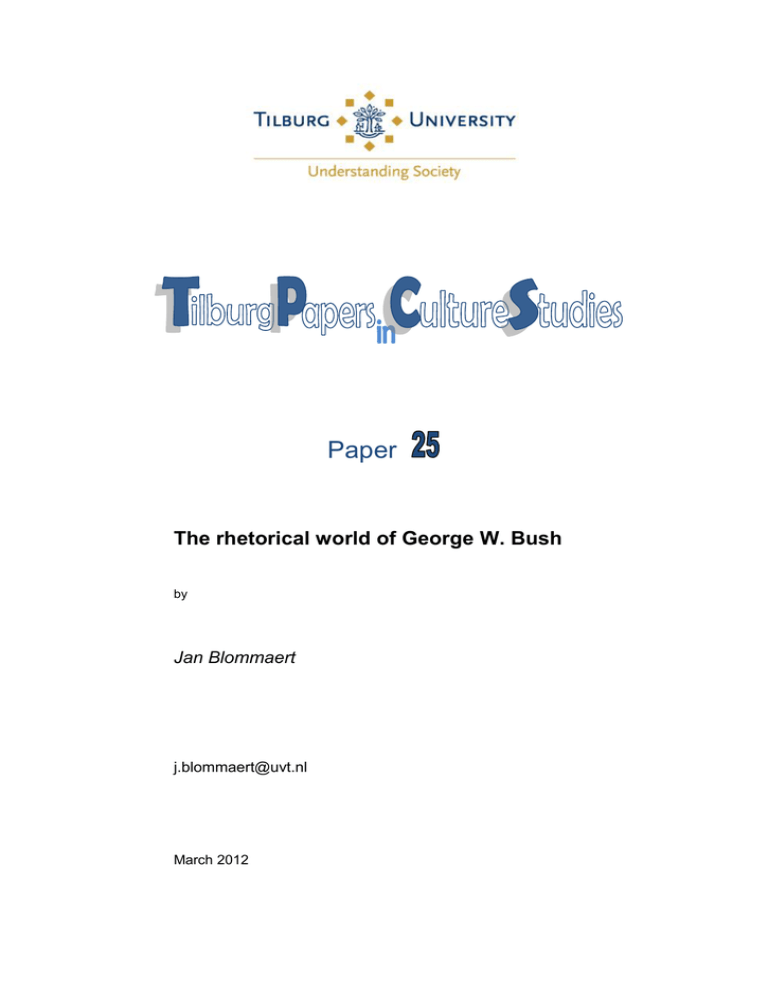
Paper The rhetorical world of George W. Bush by Jan Blommaert j.blommaert@uvt.nl March 2012 The rhetorical world of George W. Bush Jan Blommaert An important part of political science rests on the analysis of the public and institutional discourse of politicians. Their speeches, memoirs, archives, interviews provide the historian of past politics or the analyst of current politics with a window on the ideas, dogma’s and ideological preoccupations of politicians, and they thus provide some degree of ‘insiders’ view’ on political developments or events. Most prominent politicians have left abundant data; in fact, many politicians made sure they left abundant data to the scholars. And scholarship in conjunction with collective political memory has lifted some of their speeches or statements to the status of emblems of an epoch, icons of a type of (heroic) person, or near-proverbial sayings articulating universal wisdom. Examples abound: Martin Luther King’s ‘I had a dream’, Lincoln’s Gettysburg Address, Churchill’s Iron Curtain speech, Kennedy’s ‘Ich bin ein Berliner’, De Gaulle’s ‘Français, Françaises, aidez-moi!’ and so on. Command of rhetorical skills has been, and to some degree still is, a prerequisite for high office. The leader of a country or of an important fraction of the polity was, and still is, a great communicator, someone whose words are required to incorporate the thoughts and worries of the people, and someone whose words are required to emanate the ‘spirit’ – one might also call it ideology – of the people. Just as we do in everyday life with people around us, we judge politicians very much by the ways in which they communicate, categorizing them as ‘serious’ or ‘a joke’, as ‘commanding respect’ or ‘uninspiring’, as heroes or wimps, as people who could rise to the moment and take a courageous decision or people who faltered, doubted themselves and hesitated to do what was right. We combine such features of communication style with other features of personality – the looks, the recognizable features of ethnic, regional, educational or class background - and blend them into ‘image’. There are no standard criteria for such judgments about communication style. Such criteria tend to be contingent, they depend on who, what and how, on concrete circumstances, and most of all on how they fit with other features. Thus Bill Clinton could afford a certain degree of machismo in his style because of associative links between such a style of speaking with an 1 overall image of the ‘Southern US male’, a species apparently renowned for sexism and machismo. Ronald Reagan’s toughness was made larger than life and more convincing because it blended so well with his grandfatherly, friendly appearance – when a friendly old man gets angry, it’s genuine. Mitterand’s carefully constructed proletarian background was the perfect vehicle for a very De Gaullian (even ancient regime) style of public address. And Iron Lady Margaret Thatcher was tough as a rock, yet the queen of friendly, conversationalized public interaction – a style which invoked images of middle-class everyday rationality. Not everyone, however, was a fabulous orator. Richard Nixon, Gerald Ford, Jimmy Carter, George Bush Sr., John Major: none of them was impressive or memorable as a speaker. But all of them spoke and wrote, all of them left a record that can now be explored and compared by scholars. They can be judged as mediocre orators because we can compare them to great communicators, because they have left something that can be compared. A traditional analysis of the rhetoric of George W. Bush is nearly impossible. The reason is straightforward: there is nothing to be analyzed traditionally. The president of the US appears to be a non-rhetorical politician, a non-communicator. This, I believe, is politically significant and begs all kinds of comparative questions.1 Fortunately, evidence of absence is not absence of evidence. Even if George W. Bush does not communicate publicly in the way all of his predecessors did, this absence is not a negative thing, not a void, but a positive thing, the production of public silence. Seen from this angle, we may start analyzing such silence as rhetoric, or at least, as an ingredient of a rhetorical world in which George W. Bush himself only plays a marginal direct role. Yet he is omnipresent, indirectly and through the communicative acts of others. This, I believe, leads us right into the heart of contemporary power politics and how we should appraise it. *** Here are some basic observations. To the extent that we have seen Bush perform publicly, he is probably the worst speaker in his political league. Manifestly not at ease in impromptu public 1 I am greatly inspired in formulating such questions by Michael Silverstein’s Talking politics: The substance of style from Abe to ‘W’ (Chicago: Prickly Paradigm Press, 2003). Silverstein insightfully compares the two extremes of American presidential discourse: Abraham Lincoln and George W. Bush. This essay can be seen as a commentary on and an extension of Silverstein’s argument. 2 speaking events, he would start producing statements replete with catastrophic grammatical, terminological and pragmatic errors.2 He would produce oxymorons, nonsensical sentences, errors in syntax and pronunciation with breathtaking frequency, thus offering material sufficient to make the careers of several stand-up comedians and cartoon artists. He looked and sounded eminently incompetent; his whole background emanated incompetence: he did not have academic or intellectual credentials, he only seemed to have some degree of expertise in baseball affairs, he had had an alcohol problem, there were rumours of financial mismanagement in some of his business ventures, and he was his father’s son. He seemed to struggle with dyslexia, and he made the international headlines when he managed to choke on a pretzel while watching a sports game on TV in the White House. Combine all of this, and Bush is a pretty well-defined figure in everyone’s memory. We all have precise recollections of Bush as a performer in communication. He seems to have been all over the place since he came to power in 2000. But let us begin by asking: when did we really see and hear him talk? On what exposure has our well-defined image of Bush been based? This is where the problem starts. Bush has spoken very little, or at least, we have seen and heard him speak on very few occasions. Let us not forget that usually, we see people like Bush only to the extent that they offer opportunities for media coverage: press conferences, broadcasted or printed speeches, interviews in newspapers or on radio and TV. In other words: Bush has to set up events where mediators – the media – can take his words and show hem to large audiences. And looking back, we discover that there have been precious few such occasions. Real, abundant exposure to Bush’s public discourse occurred during the presidential campaign of 2000. The presidential campaigns in the US are explosions of public rhetoric, as candidates have to expose the public to their rhetoric, enabling them to make the kinds of judgments mentioned above, judgments that determine voting behaviour. Candidate Bush travelled his country and appeared at big rallies, in football arenas, hospitals, factories, schools, with an army of journalists in his tracks. It is during that time that the image of the anticommunicator Bush was formed. Having to respond on the spot to questions of some complexity and sometimes formulated with some aggressiveness, Bush froze and muttered his immortal incoherent syllables. As soon as he was elected, however, the degree of exposure changed 2 Silverstein describes this as “those deer-in-the-headlights freeze-ups when the guy was asked a substantial question of fact” (p.86) 3 dramatically. From then on, Bush only appeared during carefully scripted events. Whenever the public was exposed to President Bush speaking at some length, the public saw and heard Bush read something which was written by others, saw him respond to questions with carefully rehearsed, snapping one-liners, or saw him perform innocent routinised discursive acts such as producing pep-talk to soldiers or war veterans. Much of the uptake of his words was also studiously regimented: White House journalists were allowed to quote only ‘official’ (i.e. written and edited) versions of Bush’s statements, and not every public appearance of the president could be filmed.3 During such carefully scripted events, Bush did rather well. The speeches he gave on and after the September 11 events, or his State of the Union addresses, were all rather decently delivered, if one forgives the iconic mismatch between words of some gravitas and a facial expression dominated by what looks like an ironic grin. So the penetrating image we have of Bush as a public speaker is not matched by an avalanche of speaking events, on the contrary, it is fed piecemeal with materials that to some extent contradict the image of the incoherent, nonsense-producing George W. Bush. Bush is not doing too badly when he speaks; but he speaks very little.4 *** Yet he is very much present, and judging from his rise in popularity after September 11, he has been able to convince significantly more Americans of his leadership qualities than the small number that actually voted for him. This is where we have to start delving into the rhetorical world of George W. Bush, the way in which he has become the face added to the words of others. A look at some data collected from the American media in the first months of 2003 – the build-up to the second Gulf War - will make this clear. The dearth of directly spoken words by the president is compensated by a tremendous amount of showing the president, quoting the president in indirect speech, and talking about the president. News readers would talk about the president while a picture of the president would be shown in the corner of the screen, or they would voice-over while video footage of the president 3 Silverstein p. 87. This has been noted by some observers. When Bush gave the White House Press Conference from which I will quote below, the press noted that this was only his seventh press conference. His predecessor Bill Clinton had given ten times as many press conferences during an equivalent period in office. 4 4 is being shown. Spectators do not, however, hear the president. The talking is done by the news readers who provide stand-in eloquence, coherence and style. Interestingly, the pictures video images of the president often depict communication performed by the president: the president giving a public address, having a conversation, making phone calls. And the news reader also often describes the president as performing elaborate, important acts of communication. Let us look at an example. The NBC5 late evening news of March 11, 2003 was announced by a short trailer, announcing the main item: President Bush is working hard to canvass support for a UN Resolution sanctioning war against Iraq. We hear the voice of a news reader and we see a very brief video image of Bush giving a speech. Bush is shown as speaking seriously but intensely, movements of the left arm punctuating his (inaudible) words. The background shows an American flag and a blue board with the logo ‘Edge America’. As soon as the news program itself begins, the item is broached. It is a long item by American standards, taking the best of five minutes. The news reader starts by announcing that “President Bush has been working the phones” to convince world leaders to support the US and UK position on Iraq. In the corner of the screen, we see a picture of the president in action: in shirtsleeves on the phone. Some other images are shown and then, after about one minute, the news reader announces that “the president feels that he has enough support” to have the US Resolution passed by the UN Security Council. Again we see the same picture of Bush on the phone, this time in full screen mode. The news reader turns to similar efforts of the UK, and states that Tony Blair insists that such a Resolution is crucial. The face of Tony Blair flashes on the screen. In contrast to Bush, however, Blair speaks. We see and hear Blair produce one sentence, saying that the failure to pass the US-UK resolution would be a very bad signal: “the message it sends to Saddam is … ‘You’re off the hook’”. The item then turns to the American military preparations in Kuwait, and images are shown of American troops in the desert. The news reader again refers to the president: “Even though President Bush has not yet given the order…” the troops are ready. In this five-minute item, the president is shown three times, and three descriptive references are made by the news reader to presidential communicative activities. Even though one of these descriptions expresses a personal state of mind – “the president feels that he has enough support” – this does not seem to be reason enough to let the president speak for himself. How does a NBC news reader know how and what the president feels? Because the president 5 speaks indirectly. TV Stations are fed with carefully drafted communiqués of how the president feels, what he has said, what he is going to say, how he is going to say it. And some mute images of the president shown while communicating back this up. The result is somewhat baffling: here we have a US president who appears to be caught in a system of representations that goes back to the pre-sound era of cinematography: Rudolf Valentino whispering the sweetest words in a lady’s eras, but nobody could hear them and everybody imagined these words to be the sweetest ever said. There is an excessive amount of institutional pudeur about George W. Bush’s acoustic self, a pudeur that does not apply to Tony Blair, who can be shown and heard while speaking. Neither does it apply to Colin Powell, Condoleezza Rice, General Tommy Franks or John Ashcroft. But the absence of presidential talk is painful, to an extent that the ABC programme “60 minutes” decided in March 2003 to have weekly debates between former President Bill Clinton and his former opponent Bob Dole – an expression of nostalgic longing (bound to be disappointing) for the days when Presidents could be heard and seen every day. *** Let us now have a look at the words spoken by the president himself. As said before, they are preciously rare. On TV, Bush can only be directly heard during a handful of seconds, in statements usually inserted in longer descriptive narratives on an ‘item’ by a news reader, much like the one-line statement by Blair in the example above. The setting is either (most often) a public speech given on some occasion, statements made during visits from foreign leaders to the White House, or (very few) statements made during or after other meetings in the White House or elsewhere. In these few seconds, one or two sentences would be broadcasted. When the sentences are taken from a public speech, they are often followed by the audible beginning of applause. Such broadcasted sentences are always ‘emblematic’ ones, the ones that provide the political keywords sensed to express the essence of an issue or of America’s stance towards the issue: “freedom”, “democracy”, “the freedom-loving nations”, “the free world”, “we are proud”, “we shall prevail”, “we shall disarm Saddam”, “we shall protect the safety of our citizens”, “we shall 6 protect the world” and so on.5 President Bush pronounces them with some bravado and the keywords trigger applause from audiences well accustomed to this style of rhetoric. Applause almost always comes at scripted points in the speeches, Bush is never caught by surprise, he never has to stop in mid-sentence and wait for applause to die down, and his audiences are well trained to react with applause at the agreed-upon moments only. When such bits of speeches are broadcasted, they suggest all kinds of things. They suggest that the broadcasted fragment is a highlight in the speech, something that exceptionally enthused the audience and made it react in explosive support to the president. They thus suggest coherence in the speech – broadcasting the fragment suggests the existence of a whole, coherent, elaborate speech in which the particular fragment assumes a special role, that of ‘most important’ or ‘most relevant’ bit. Thus, such bits of speeches suggest eloquence and rhetorical skill, the distinctive (and distinguished) discursive features of leadership. But it is rather disappointing to see the whole event. Bush’s State of the Union address of 2003 took nearly one hour. It was a smooth delivery: the President looked well-prepared and well-rehearsed. He didn’t stumble over words, produced hardly any remarkable pronunciation errors, and worked his audience well. Or did he? Wasn’t it the other way around? What I observed was a fantastic co-production between speaker and audience, the audience producing thunderous applause literally every one and a half minute during big parts of the speech. Bush would produce five sentences culminating in the usual key words of America-in-the-world, and the Congress would respond in an almost Pavlovian fashion with warm and encouraging applause. Thus both parties, speaker and audience, were producing the much-welcomed ‘chunks’ of the speech, ready-made for insertion in the TV news programmes that would cover the speech. There were no long, grammatically complex sentences, there was hardly any stylistic baroque, and there was not a single intellectually or politically engaging argument. The speech was not made for Congress, neither was it made for the American public. In effect, it wasn’t a speech in the classical sense of the term, it was a patchwork of small separate units of thematically organized sentences, building towards a terminological climax, and followed by applause. It was a supermarket shelf of bits of speech from which the TV stations could pick their preferred goods 5 Silverstein (p.87) notes that such keywords sum up, and suggest comprehension of, complex realities. They are also vague enough to allow anyone to project onto these terms his/her own concrete agendas, experiences and real- life conditions of existence. Left or right, rich or poor: everyone believes this is about me. They thus serve any audience, they are a rhetorical panacea. 7 – thirty seconds-long fragments of a strong-speaking, committed President saying the right words and greeted with enthusiasm by Congress. On March 6, 2003, George Bush gave one of his very rare White House Press Conferences, devoted to the looming war with Iraq. The event took slightly over three quarters of an hour, and it started with the president reading a statement. The statement consisted of a kind of ‘master narrative’ about America’s position. In this statement (manifestly produced for reproduction by journalists), a scheme was produced revolving around (a) the fact that the US wants to keep the peace in the world, and turns to war only as a last option; (b) Saddam Hussein’s failure to disarm his country, and his devious and diabolic character; (c) the threat Iraq poses to the US by supporting Al Qaeda and other terrorist organizations, and (d) the President’s resolve to protect the security of Americans and of the world. Some twenty questions were asked by journalists, selected by Bush himself from a list of names on his table.6 Remarkably, Bush managed to answer every single one of them by means of this master narrative. Questions would be asked on various topics ranging from the growing aversion against US foreign policy in large parts of the world to the potential costs of a war for the US taxpayer and the importance of prayer for Bush in these times of momentous decisions. Bush would start answering the questions with impromptu, unscripted lines, rather hesitantly produced but in an obvious effort to address the issue at hand. During these impromptu moments of the answers, we would get some ‘Bushisms’, or what Michael Silverstein would call instances of “Presidentiary misspeakingfulness”, such as the following one: “Those are immeasurable costs …. And I weigh those very seriously, Ed, in terms of the dollar amount” But as soon as possible without losing too much face, Bush would seek refuge behind the nicely rehearsed, glib lines of his master narrative. Here is how he responded to a complex, three-part question on (i) whether this war was not a personal matter between Bush and Saddam Hussein, (ii) whether Bush could give some information on worst case scenarios, and (iii) whether he could comment on the costs of this war to the US. What follows is a literal transcript of the 6 Bush himself made an ironic comment about the structure of this event. At one point he dismissed one journalist’s bid to ask a question with “I’ll be right back to you – y’know, this is scripted”, followed by the name of a journalist from the list in front of him. 8 answer, in which I will show the stylistic make-up of the answer such as divisions in thematic and stylistic units. I will provide nonverbal information between square brackets. The whole question and answer sequence takes about two minutes. Ehr …. [looks ahead] my job is to protect America That’s exactly what I’m gonna do People can ascribe all kinds of eh.. intentions [looks down] I swore to … protect and defend [looks up] the Constitution that’s what I swore to do [raises right hand] I put my hand on the Bible and took that oath and that’s exactly what I’m gonna do I believe Saddam Hussein is a threat to the American people I believe he’s a threat to the neighbourhood in which he lives And I gotta get evidence for to believe that He has weapons of mass destruction And he has USED weapons of mass destruction In his neighbourhood and on his own people He’s invaded countries in his neighbourhood He tortures his own people He’s a murderer [looks down and up] He has trained and financed Al Quaeda-type organizations before Al Quaeda and other organizations [looks down and up] I take that threat seriously And I’ll deal with the threat I hope it can be done peacefully 9 At this point Bush turns to the journalist and asks: “the rest of your six-point questions?”. The journalist reminds him of the issue of costs; Bush looks down, then up and replies: The price of doing nothing exceeds the price of taking action if we have to We’ll do anything we can to minimize the loss of life The price of the attacks on America – The costs of the attacks on America on September the eleventh were enormous They were significant And eh .. I’m not willing to take that chance again. Bush is speaking in a most remarkable style, declamation. Each line in the transcript is followed by a long pause, with the exception of lines ending with a dash. He speaks slowly, solemnly and in a truncated prosody, and with lots of parallelisms and repetitive refrains. He looks repeatedly down at what is in front of him on his table – the statement which he delivered prior to the questions, the statement with all the phrases of the master narrative. And we do get these phrases, in fact, we get nothing else. Bush loses his way in his narrative and has to ask the journalist to remind him of the questions, which seem to be forgotten halfway through the answer. In the last part of the answer, we see how he rephrases his statement, substituting the journalist’s prompt term “costs” for “price” – a term probably closer to the rehearsed master narrative and a glimpse of the tension between the urge to stick to the safe, prepared story and the need to address the questions asked by the journalist. And the core of the answer is on the one hand an evocation of his presidential duties (I swore, I took an oath, that’s what I shall do) and a series of images about the enemy, Saddam Hussein, formulated in a strongly personal way (I gotta get evidence, I take that threat seriously). Throughout, he reiterates all the elements of the master narrative given in his statement at the beginning of the press conference. He not only produces this kind of reiterative rhetoric in this particular answer to this particular question: he uses it in every answer he gives. The forty five minutes of the press conference are a sequence of reconfigured mixtures of the same elements, the elements of one single, basic, sketchy story. Evidently, no major TV station broadcasts the whole of the press conference, they all broadcast the bits discussed above. And just as in the case of the State of the Union address, the 10 audience believes they get, and effectively do get, the full story by listening to the single bit. Any single (fragment of an) answer can be put on the air, the public will hear the same master narrative. *** It is highly unclear what the real function of the direct audiences is – the Congress in the case of the State of the Union and the White House Press Corps during the press conference. It is clear though, that they are not the main audience. The main audience is TV-watching America, who will get their bits of speech metonymically articulating a supposedly complex political analysis packed with expertise, facts and wisdom. The audiences in the room are part of the staging of TV-events: the State of the Union requires an audience of members of Congress, and the press conference requires an audience of journalists, just as a book needs a cover and a painting needs a frame. It is a genre requirement that demarcates different genres such as ‘press conference’ and ‘State of the Union’. Those are the attributes of the president communicating democratically across a wide variety of audiences representing the various layers and forces in society. The genre paraphernalia iconically suggest this democracy, this president who has to answer to all kinds of groups in society. But in fact there is only one genre, and only one audience. The genre is what the media will do with presidential talk: the fabrication of ultra-short, indirect, highly suggestive and iconic replicas of the president-as-communicator. And the audience is TV-watching America, millions of people who believe they see the macroscopic image through microscopic replicas of it, and who believe they are ‘informed’ by this telescopic suggestion. In a highly ambivalent way, the press is an accomplice, as they produce this reduction of patterns of communication sensed to be characteristic of a democracy. They have to: it supports their own ideology of the ‘free media’ as the cornerstone of democracy. But the result is that the White House has an easy ride: they feed the press with the pre-packaged, rhetorical finished products described here, knowing that journalists will absorb the simplest and most naïve or counterfactual narratives and reproduce them as condensed versions of weighty, trustworthy ‘information’. The White House knows that this funnel offers golden opportunities to pump the politically desired master narratives to the 11 American public and to repeat them over and over again. They know that this system is a propaganda system.7 It is during the brief moments when rules are broken that we see the rules at work. Toward the end of a White House Press Briefing on February 25, 2003, White House Spokesman Ari Fleischer was challenged by a journalist about the rumours that the US were offering various kinds of benefits to UN Security Council members willing to support the US. Fleischer first answered with a classic master narrative line emphasizing that such countries were now representing the world and would rise to the occasion. The journalist, however, insisted, and Fleischer again reverted to a fine line, probably believing that he was delivering the knock-out blow: “But think about the implications of what you’re saying. You are saying that foreign leaders are buyable. And that is not an acceptable proposition.” To his surprise and dismay, the Press Corps spontaneously burst into a loud salvo of laughter. And while the laughs and sarcastic comments continued, Fleischer gathered his papers and left the Press Room. Fleischer had apparently gone too far in his attempt to feed the press with propaganda, and the journalists put him in his place. But in doing so, they displayed an awareness of the rules of the game that was going on. We’ll print everything, but this is just oversized. *** Within this rhetorical world, Bush is a great communicator, or at least, an adequate communicator. His manifest lack of rhetorical ability is compensated by the fact that presidential communication, in the contemporary symbolic economy, is not something the president has to do alone. By lack of great performances from the principal producer, the secondary producer of presidential rhetoric, the press, takes over and produces abundant, suggestive, embellished and stylized rhetoric on and on behalf of the president. The press makes sure that the US have a 7 Thus the master narrative described in this example was not invented for this occasion only; it was developed several months earlier and was repeated over and over again. During his fifteen-minute television address to the nation on March 17 (the speech in which he announced that diplomacy had failed and gave Saddam Hussein 48 hours to leave Iraq), exactly the same master narrative was used. 12 president who is eloquent, witty, determined and presidential. The press does this, because the president is the biggest of all American celebrities, someone whose presence in the media is absolutely necessary. The president also needs to be appropriated and spoken for by the press, because the press needs the imagery of information in a democratic society to protect its own legitimacy. As a consequence, even a very silent president can speak politically, and speak a lot. He can speak better this way than if he would attempt to dominate presidential rhetoric himself. And in this way, a cynical administration suffering from a chronic lack of democratic legitimacy but skilled in the techniques of communication that generate legitimacy manages to project George W. Bush as a ‘full’, democratically legitimate president. His regime can be imagined – literally – as a truly American democracy. Just like the suggestion that Coca-Cola Light has the same flavour as regular Coca-Cola works, provided you produce this suggestion the right way and with debilitating frequency, the Bush people have managed to suggest that a ‘light’ democracy has the same flavour as a regular one, that their ‘Light’ leader has the same flavour as the previous, high-calorie one; in fact, that this Light Leader is better for your health and makes you live longer. (This essay was written in 2003, in dialogue with Michael Silverstein, whose input and inspiration is gratefully acknowledged here. A Dutch version of this text appeared as “De retorische wereld van George W. Bush” in Samenleving en Politiek 10/5, 2003: 43-53) 13
